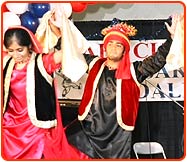Tuesday, April 6, 2010 | 10:50:00 PM
Baisakhi Dress
 |
Traditional Bhangra Dress (for Men)
Dress for Bhangra is as colourful and vibrant as the Bhangra dance itself. Bhangra costumes effectively portrays the rich and vivid colors of rural Punjab and also the zest for life of Punjabi folk. Bhangra costume is simple and is normally worn by the men in rural Punjab, in lighter hues though ! Before we study how the Bhangra costume looks like let us see what exactly constitutes the traditional Bhangra dress for men !!
Parts of Bhangra Dress
- Turla or Torla (fan like adornment on the turban)
- Pag (turban, a sign of pride/honor in Punjab): This is tied different to the traditional type of turban that you can see Sikh's wearing in the street. The turban has to be tied before each show, and is not ready made like a hat.
- Kaintha (necklace), some men also wear earrings
- Kurta - Similar to a silk shirt, with about 4 buttons, very loose with embroidered patterns.
- Lungi or Chadar - This is a loose loincloth tied around the dancer’s waist. Again it would be decorated.
- Jugi: A waistcoat, with no buttons.
- Rammal: These are essentially scarves worn on the fingers. They look very elegant and effective when the hands move during the course of bhangra performance.
Quite often the kurta of bhangra dancer is in white color but the use of other bright colours can also be normally observed in modern times. Lungi, vest and pag are of the same colour. Bright shades like yellow (to symbolize sarson, mustard), green (meaning prosperity), red (auspicious saffron) are mostly chosen for these. Lower part of a bhangra dress is a lungi. This is a rectangular piece of cloth tied around the waist. Men also wear juttis (Punjabi shoes), but dance barefoot.
Traditional Gidda Dress (for Women)
Traditional dress for gidda is quite elegant. It adds charm to feminine grace and is comfortable enough to allow women to perform giddha dance with ease. Giddha dress is quite simple and one can find women in rural Punjab donning it everyday. The only difference is that costume for giddha makes use of brighter colors and is complemented with heavy jewellery.
Parts of Gidda Dress
- Dupatta (chunni or scarf): This is heavily embroidered in a gidda costume.
- Kameez (shirt)
- Salwaar (baggy pants)
- Tikka (jewellery on the forehead)
- Jhumka (long dangling earrings)
- Paranda (braid tassle)
- Suggi-Phul (worn on head)
- Raani-Haar (a long necklace made of solid gold)
- Haar-Hamela (gem-studded golden necklace)
- Baazu-Band (worn around upper-arm)
- Pazaibs (anklets)
Women performing giddha dance also adorn themselves with a lot of jewellery including bangles, tikka, jhumkas, necklace and nath (nose ring). Characteristic feature of gidda dress is a paranda - a tassle that is woven into the braid. Womenfolk love to go in for longer and fancier parandas.
Posted By


